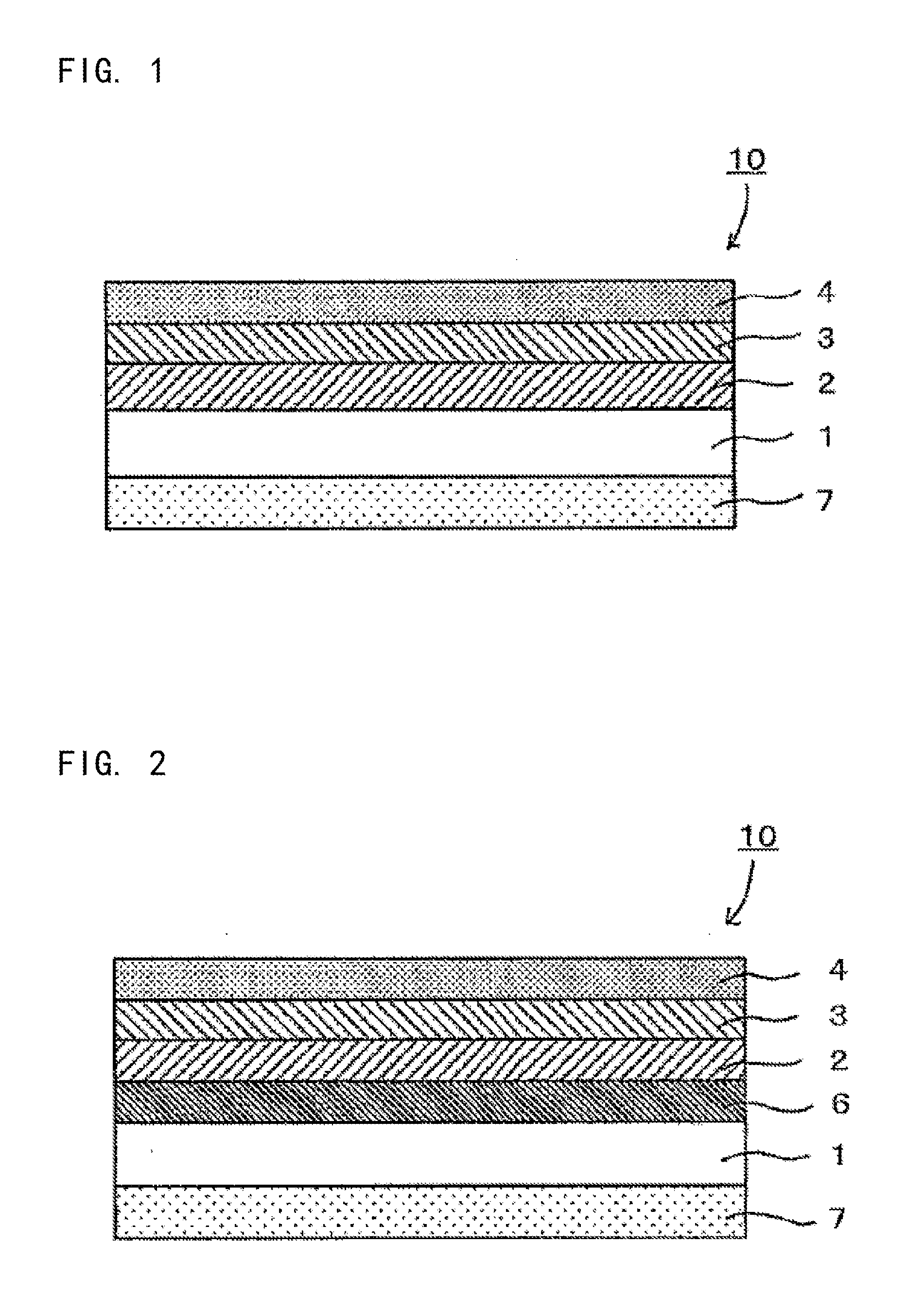Thermal transfer image-receiving sheet and manufacturing method for thermal transfer image-receiving sheet
a technology of thermal transfer image and receiving sheet, which is applied in the direction of thermal imaging, synthetic resin layered products, coatings, etc., can solve the problems of adverse effect of adhesion between the barrier layer and the receiving layer, poor adhesiveness of polyvinyl alcohol, etc., and achieve good coating suitability and solvent resistance. good
- Summary
- Abstract
- Description
- Claims
- Application Information
AI Technical Summary
Benefits of technology
Problems solved by technology
Method used
Image
Examples
first embodiment
Barrier Layer of the First Embodiment
[0037]The barrier layer 3 of the first embodiment includes (i) (A) the first acrylic resin and (B) one or more kinds of resins selected from the group consisting of the polyester resins, the polyvinyl pyrrolidone type resins, the polyester type urethane resin, and the second acrylic resin which differs from the first acrylic resin. Now, the ingredients included in the barrier layer of the first embodiment will be specifically described.
(First Acrylic Resin)
[0038]In the barrier layer of the first embodiment, the first acrylic resin is included as an essential constituent component. Among various resinous components, the acrylic resin is excellent in solvent resistance and adhesion. Therefore, through the addition of the first acrylic resin in the barrier layer 3, the solvent resistance and the adhesion property is given to the barrier layer 3. In the present invention, the first acrylic resin is included in the barrier layer 3, with a principal vi...
second embodiment
Barrier Layer of the Second Embodiment
[0074]The barrier layer 3 of the second embodiment contains polyvinyl pyrrolidone type resin. The barrier layer 3 which contains the polyvinyl pyrrolidone type resin excels in the solvent resistance, as well as the adhesiveness to the porous layer 2 and the receiving layer 4. Therefore, when providing the barrier layer 3 which contains the polyvinyl pyrrolidone type resin between the porous layer 2 and the receiving layer 4, the first mode the same manner as the barrier layer, it becomes possible to prevent the porous layer 2 from destruction which is due to a solvent for forming the receiving layer 4, and it becomes possible to adhere the porous layer 2 and the receiving layer 4 firmly, as is the case of the barrier layer of the first embodiment.
[0075]As the polyvinyl pyrrolidone type resin to be contained in the barrier layer 3 of the second embodiment, those described above for the barrier layer 3 of the first embodiment 3 can be used in perf...
example 1
[0107]As the substrate, RC paper (STF-150, manufactured by Mitsubishi Paper Mills, 190 μm) was availed. On this substrate, a liquid for forming porous layer having the following composition was coated so as to obtain a thickness of 8-10 g / m2 in the dried state, and thereby a porous layer was formed. Subsequently, a liquid 1 for forming barrier layer having the following composition was coated on the porous layer so as to obtain a thickness of 1.0 g / m2 in the dried state, and thereby a barrier layer was formed. Next, a liquid for forming receiving layer having the following composition was coated on the barrier layer so as to obtain a thickness of 2.5 g / m2 in the dried state, and thereby a receiving layer was formed. Ultimately, a thermal transfer image-receiving sheet of Example 1 in which the substrate / the porous layer / the barrier layer / the receiving layer were layered in the order was prepared.
Hollow particles (average particle size: 1 μm)70 parts(HP-91, manufactured by Rohm and H...
PUM
| Property | Measurement | Unit |
|---|---|---|
| thickness | aaaaa | aaaaa |
| thickness | aaaaa | aaaaa |
| porosity | aaaaa | aaaaa |
Abstract
Description
Claims
Application Information
 Login to View More
Login to View More - R&D
- Intellectual Property
- Life Sciences
- Materials
- Tech Scout
- Unparalleled Data Quality
- Higher Quality Content
- 60% Fewer Hallucinations
Browse by: Latest US Patents, China's latest patents, Technical Efficacy Thesaurus, Application Domain, Technology Topic, Popular Technical Reports.
© 2025 PatSnap. All rights reserved.Legal|Privacy policy|Modern Slavery Act Transparency Statement|Sitemap|About US| Contact US: help@patsnap.com


